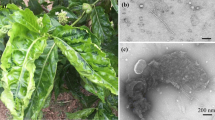Abstract
Tobacco streak virus (TSV, genus Ilarvirus family Bromoviridae) is known to cause stem necrosis disease (SND) in groundnut (Arachis hypogaea) since 2000 in Southern India. The TSV isolate infecting groundnut so far has not been characterized based on the complete genome sequence. In this study, TSV was isolated from a naturally infecting groundnut plant in Kadiri, the hot-spot of the SND in southern India. During the Kharif season of 2014, groundnut plants in an experimental field were affected with chlorosis and necrosis in leaf, stem and buds. The cent percent of the 48 samples with these symptoms collected from the field tested positive for TSV in ELISA samples in this context. One isolate, GN-Kad was established from a single lesion on cowpea cv. C-152 through successive sap inoculation. Cloning and sequencing of coat protein gene (717 nucleotides) of the isolate showed high sequence identity (98–99%) with the TSV isolates reported from different crops in India. The isolate produced local necrotic rings or veinal necrosis following sap inoculation to cowpea (cultivars C-152, Pusa Komal, Pusa Sukomal and Krishi Kanchan), French bean and sunflower; whereas, it produced systemic chlorotic mottling symptoms in Nicotiana benthamiana. The three segments of the virus genome (RNA 1, RNA 2 and RNA 3) contained 3523, 2903 and 2232 nucleotides, respectively. The overall genome sequence (8639 nt) of the present isolate shared 77–99% of nucleotide sequence identity with that of the other seven isolates reported from Australia, India and USA. The GN-Kad shared very close phylogenetic relationship with the okra and pumpkin isolates reported from India. The present report is the first comprehensive study of the molecular characterization of TSV associated with the stem necrosis disease of groundnut.




Similar content being viewed by others
References
Arunkumar N, Lakshmi NM, Usha BZ, Ravi KS. Natural occurrence and distribution of Tobacco streak virus in south India. Indian J Plant Prot. 2006;34:54–8.
Bhat AI, Jain RK, Chaudhary V, Krishna Reddy M, Ramaiah M, Chattannavar SN, Varma A. Sequence conservation in the coat protein gene of Tobacco streak virus isolates causing necrosis disease in cotton, mungbean, sunflower and sunn-hemp in India. Indian J Biotechnol. 2002;1:350–6.
Bhat AI, Jain RK, Kumar A, RamiahM VA. Serological and coat protein sequence studies suggest that necrosis disease on sunflower in India is caused by strain of Tobacco streak ilarvirus. Arch Virol. 2002;147:651–8.
Chander Rao S, Prasada Rao RDVJ, Manoj Kumar V, Divya S, Raman M. First report of Tobacco streak virus infecting safflower (Carthamustinctorius) in Maharashtra, India. Plant Dis. 2003;87:1396.
Clark MF, Bar-Joseph M. Enzyme immunosorbent assays in plant virology. Methods Virol. 1984;2:51–85.
Jain RK, Bag S, Awasthi LP. First report of natural infection of Capsicum annuum by Tobacco streak virus in India. Plant Pathol. 2005;54:257.
Krishnareddy M, Salil J, Samuel DK. Outbreak of Tobacco streak virus causing necrosis of cucumber and gherkin in India. Plant Dis. 2003;87:1264.
Krishnareddy M, Vemana K, Kumar S. In: Mandal B, et al., editors. A century of plant virology in India. Singapore: Springer; 2017. p. 271–84.
Ladhalakshmi D, Ramiah M, Ganapathy T, Krishna Reddy M, Khabbaz SE. First report of the natural occurrence of Tobacco streak virus on blackgram (Vigna mungo). Plant Pathol. 2006;55:569.
Prasad Rao RDVJ, Reddy AS, Chander Rao S, Varaprasad KS, Thirumala DK. Tobacco streak Ilarvirusas causal agent of sunflower necrosis disease in India. J Oilseeds Res. 2000;17:400–1.
Ravi KS, Buttgereitt A, Kitkaru AS, Deshmukh S, Lesemann DE. Sunflower necrosis disease from India is caused by an Ilarvirusrelated to Tobacco streak virus. Plant Pathol. 2001;50:800.
Reddy AS, Prasada Rao RDVJ, Thirumala-Devi K, Reddy SV, Mayo MA, Roberts I, Satyanarayana T, Subramaniam K, Reddy DVR. Occurrence of Tobacco streak virus on peanut (Arachis hypogaea) in India. Plant Dis. 2002;86:173–8.
Vemana K, Jain RK. New experimental hosts of tobacco streak virus and absence of true seed transmission in leguminous hosts. Indian J Virol. 2010;21:117–27.
Vinodkumar S, Nakkeeran S, Malathi VG, Karthikeyan G, Amala Balu P, Mohankumar S, Renukadevi P. Tobacco streak virus: an emerging threat to cotton cultivation in India. Phytoparasitica. 2017;45:729–43.
Acknowledgements
Authors are thankful to the Department of Science and Technology, Government of India for supporting the Indo-Japan Joint Research Project (DST/INT/JSPS/P-222/2016).
Author information
Authors and Affiliations
Corresponding author
Electronic supplementary material
Below is the link to the electronic supplementary material.
Rights and permissions
About this article
Cite this article
Daliyamol, Jailani, A.A.K., Vemana, K. et al. Complete genome sequence and phylogenetic relationships of tobacco streak virus causing groundnut stem necrosis disease in India. VirusDis. 30, 227–236 (2019). https://doi.org/10.1007/s13337-018-0500-2
Received:
Accepted:
Published:
Issue Date:
DOI: https://doi.org/10.1007/s13337-018-0500-2




